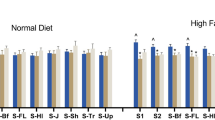Abstract
This experiment examined dopamine D2 receptor and its transporter (DAT) density in mice fed a high-fat or low-fat diet for twenty days as well as fed twenty days of high-fat diet then changed to low-fat diet for one and seven days. Quantitative autoradiography revealed that twenty days of high-fat diet consumption significantly increased D2 receptor and decreased DAT density in the dorsal and ventral parts of the caudal caudate putamen (D2: 32% and 35% respectively, DAT: 33.3% and 28.8% respectively) compared with low-fat diet. High-fat feeding also increased D2 binding in the nucleus accumbens shell (36%). D2 receptor and DAT density remained unchanged following reversal of the diets from high-fat to low-fat diet. The high-fat diet induced increase of D2 receptor and decrease of DAT binding may have occurred due to defensive control over dopaminergic activity in response to a positive energy balance.



Similar content being viewed by others
References
Roefs A, Quaedackers L, Werrij MQ et al (2006) The environment influences whether high-fat foods are associated with palatable or with unhealthy. Behav Res Ther 44(5):715–736
Rissanen A Hakala P Lissner L et al (2002) Acquired preference especially for dietary fat and obesity: A study of weight-discordant monozygotic twin pairs. Int J Obes 26(7):973–977
Woods SC D’Alessio DA Tso P et al (2004) Consumption of a high-fat diet alters the homeostatic regulation of energy balance. Physiol Behav 83(4):573–578
Lin S Thomas TC Storlien LH et al (2000) Development of high fat diet-induced obesity and leptin resistance in C57B1/6J mice. Int J Obes 24(5):639–646
Hajnal A, Norgren R (2001) Accumbens dopamine mechanisms in sucrose intake. Brain Res 904(1):76–84
Hajnal A, Smith GP, Norgren R (2004) Oral sucrose stimulation increases accumbens dopamine in the rat. Am J Physiol Regul Integr Comp Physiol 286(1):R31–R37
Huang X-F, Yu Y, Zavitsanou K et al (2005) Differential expression of dopamine D2 and D4 receptor and tyrosine hydroxylase mRNA in mice prone, or resistant, to chronic high-fat diet-induced obesity. Mol Brain Res 135(1–2):150–161
Spanagel R, Weiss F (1999) The dopamine hypothesis of reward: past and current status. Trends Neurosci 22(11):521–527
Fauchey V, Jaber M, Caron MG et al (2000) Differential regulation of the dopamine D1, D2 and D3 receptor gene expression and changes in the phenotype of the striatal neurons in mice lacking the dopamine transporter. Eur J Neurosci 12(1):19–26
Pecina S, Cagniard B, Berridge KC et al (2003) Hyperdopaminergic Mutant Mice Have Higher “Wanting” But Not “Liking” for Sweet Rewards. J Neurosci 23(28):9395–9402
Ikawa K, Watanabe A, Kaneno S et al (1993) Modulation of [3H]mazindol binding sites in rat striatum by dopaminergic agents. Eur J Pharmacol 250(2):261–266
Zahniser NR, Doolen S (2001) Chronic and acute regulation of Na+/Cl− dependent neurotransmitter transporters: drugs, substrates, presynaptic receptors, and signaling systems. Pharmacol Ther 92(1):21–55
Wang G-J, Volkow ND, Logan J et al (2001) Brain dopamine and obesity. The Lancet 357(9253):354–357
Reeves PG, Nielsen FH, Fahey GC (1993) AIN-93 purified diets for laboratory rodents: final report of the American Institute of Nutrition ad hoc writing committee on the reformulation of the AIN-76A rodent diet. J Nutr 11(123):1939–1951
Paxinos G, Franklin K (2002) The mouse brain in stereotaxic coordinates, 1st edn. Academic Press, San Diego
Huang XF, Yu Y, Zavitsanou K et al (2005) Differential expression of dopamine D2 and D4 receptor and tyrosine hydroxylase mRNA in mice prone, or resistant, to chronic high-fat diet-induced obesity. Mol Brain Res 135(1–2):150–161
Kelley AE, Baldo BA, Pratt WE et al (2005) Corticostriatal-hypothalamic circuitry and food motivation: integration of energy, action and reward. Physiology & Behavior Purdue University Ingestive Behavior Research Center Symposium. Dietary influences on obesity: environment, behavior and biology. 86(5):773–795
Epstein LH, Leddy JJ (2006) Food reinforcement. Appetite 46(1):22–25
Martel P, Fantino M (1996) Mesolimbic dopaminergic system activity as a function of food reward: a microdialysis study. Pharmacol Biochem Behav 53(1):221–226
Liang N-C, Hajnal A, Norgren R (2006) Sham feeding corn oil increases accumbens dopamine in the rat. Am J Physiol Regul Integr Comp Physiol 291(5):R1236–R1239
Romon M, Lebel P, Velly C et al (1999) Leptin response to carbohydrate or fat meal and association with subsequent satiety and energy intake. Am J Physiol Endocrinol Metab 277(5):E855–E861
Romon M, Lebel P, Fruchart J-C et al (2003) Postprandial leptin response to carbohydrate and fat meals in obese women. J Am Coll Nutr 22(3):247–251
Figlewicz DP (2003) Adiposity signals and food reward: expanding the CNS roles of insulin and leptin. Am J Physiol Regul Integr Comp Physiol 284(4):R882–R892
Figlewicz DP, Evans SB, Murphy J et al (2003) Expression of receptors for insulin and leptin in the ventral tegmental area/substantia nigra (VTA/SN) of the rat. Brain Res 964(1):107–115
Hommel JD, Trinko R, Sears RM et al (2006). Leptin receptor signalling in midbrain dopamine neurons regulates feeding. Neuron 51(6):801–810
Krugel U, Schraft T, Kittner H et al (2003) Basal and feeding-evoked dopamine release in the rat nucleus accumbens is depressed by leptin. Eur J Pharmacol 482(1–3):185–187
Zhang Y, Proenca R, Maffei M et al (1994). Positional cloning of the mouse obese gene and its human homologue. Nature 372(6505):425–432
Scarpace PJ, Tumer N (2001) Peripheral and hypothalamic leptin resistance with age-related obesity. Physiol Behav 74(4–5):721–727
Kolaczynski JW, Ohannesian JP, Considine RV et al (1996) Response of leptin to short-term and prolonged overfeeding in humans. J Clin Endocrinol Metab 81(11):4162–4265
Author information
Authors and Affiliations
Corresponding author
Rights and permissions
About this article
Cite this article
South, T., Huang, XF. High-Fat Diet Exposure Increases Dopamine D2 Receptor and Decreases Dopamine Transporter Receptor Binding Density in the Nucleus Accumbens and Caudate Putamen of Mice. Neurochem Res 33, 598–605 (2008). https://doi.org/10.1007/s11064-007-9483-x
Received:
Accepted:
Published:
Issue Date:
DOI: https://doi.org/10.1007/s11064-007-9483-x




